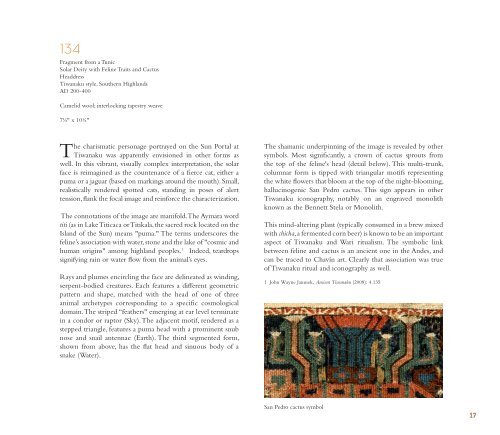You also want an ePaper? Increase the reach of your titles
YUMPU automatically turns print PDFs into web optimized ePapers that Google loves.
134<br />
Fragment from a Tunic<br />
Solar Deity with Feline Traits and Cactus<br />
Headdress<br />
Tiwanaku style, Sou<strong>the</strong>rn Highlands<br />
AD 200-400<br />
Camelid wool; interlocking tapestry weave<br />
7½" x 10½"<br />
The charismatic personage portrayed on <strong>the</strong> Sun Portal at<br />
Tiwanaku was apparently envisioned in o<strong>the</strong>r forms as<br />
well. In this vibrant, visually complex interpretation, <strong>the</strong> solar<br />
face is reimagined as <strong>the</strong> countenance of a fierce cat, ei<strong>the</strong>r a<br />
puma or a jaguar (based on markings around <strong>the</strong> mouth). Small,<br />
realistically rendered spotted cats, standing in poses of alert<br />
tension, flank <strong>the</strong> focal image and reinforce <strong>the</strong> characterization.<br />
The connotations of <strong>the</strong> image are manifold. The Aymara word<br />
titi (as in Lake Titicaca or Titikala, <strong>the</strong> sacred rock located on <strong>the</strong><br />
Island of <strong>the</strong> Sun) means "puma." The terms underscores <strong>the</strong><br />
feline’s association with water, stone and <strong>the</strong> lake of "cosmic and<br />
human origins" among highland peoples. 1 Indeed, teardrops<br />
signifying rain or water flow from <strong>the</strong> animal’s eyes.<br />
Rays and plumes encircling <strong>the</strong> face are delineated as winding,<br />
serpent-bodied creatures. Each features a different geometric<br />
pattern and shape, matched with <strong>the</strong> head of one of three<br />
animal archetypes corresponding to a specific cosmological<br />
domain. The striped “fea<strong>the</strong>rs" emerging at ear level terminate<br />
in a condor or raptor (Sky). The adjacent motif, rendered as a<br />
stepped triangle, features a puma head with a prominent snub<br />
nose and snail antennae (Earth). The third segmented form,<br />
shown from above, has <strong>the</strong> flat head and sinuous body of a<br />
snake (Water).<br />
The shamanic underpinning of <strong>the</strong> image is revealed by o<strong>the</strong>r<br />
symbols. Most significantly, a crown of cactus sprouts from<br />
<strong>the</strong> top of <strong>the</strong> feline's head (detail below). This multi-trunk,<br />
columnar form is tipped with triangular motifs representing<br />
<strong>the</strong> white flowers that bloom at <strong>the</strong> top of <strong>the</strong> night-blooming,<br />
hallucinogenic San Pedro cactus. This sign appears in o<strong>the</strong>r<br />
Tiwanaku iconography, notably on an engraved monolith<br />
known as <strong>the</strong> Bennett Stela or Monolith.<br />
This mind-altering plant (typically consumed in a brew mixed<br />
with chicha, a fermented corn beer) is known to be an important<br />
aspect of Tiwanaku and Wari ritualism. The symbolic link<br />
between feline and cactus is an ancient one in <strong>the</strong> <strong>Andes</strong>, and<br />
can be traced to Chavín art. Clearly that association was true<br />
of Tiwanaku ritual and iconography as well.<br />
1 John Wayne Janusek, <strong>Ancient</strong> Tiwanaku (2008): 4.135<br />
San Pedro cactus symbol<br />
17







